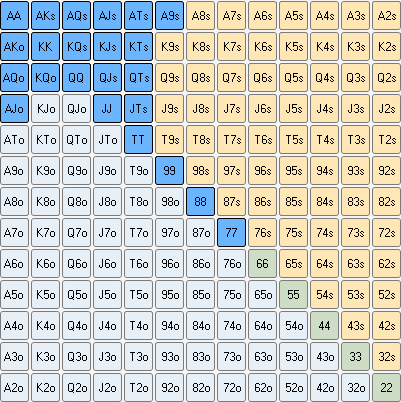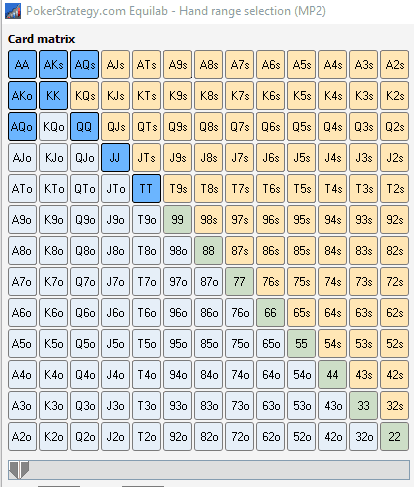Good Poker Hands Before Flop
A 2-7 offsuit hand is the worst hand to start with in Texas Hold 'Em poker because there are so few good options available to you: you have no straight draw, no flush draw, and even if you wind up with a pair of 7s or a pair of 2s, you're unlikely to have the best hand. After the flop the player in the SB will be first to act assuming he didn’t fold already. Try to play in position. Acting first in poker is a big disadvantage and is referred to as being “out-of-position”. We give away information about our hand – our opponent gets to see what we do before he acts. As a result we should –. Notice if any of the players look at their hands before it’s their turn to act. If so, then watch them do so whenever you can. If you see that a player to your left is likely to call, you may want to play your drawing hand and see if there is a multi way pot, or raise to chase them out. No hand ever has 0% equity before a flop is dealt. Just because you may have decent pot odds to see a flop doesn’t mean you always should.Often it will be difficult to fully realise your hand’s equity when you’re out of position, such as when you’re in the small or big blind.
Both before and after the flop in any limit Holdem game, it is helpful to be able to make a reasonably accurate estimate of the types and numbers of playable hands that you are likely to be competing against.
Much of your decision making involves the business of 'putting' opposing players 'on their hands' (or in other words, figuring out what cards they are playing). Experienced Holdem players are often very good at this. An understanding of the types of hands that are most likely to be against you helps prevent both underestimating and overestimating your competition.
Here are some stats that are based on the total possible combinations of various Holdem hole cards that are normally playable.
For better viewing on your mobile device (or to download or print the chart), check out holdem hole card frequencies in high resolution universal .pdf format.
The five different types of two card Hold'em hands highlighted here are those that are most commonly played. They are not shown in any particular order and within the groups are powerful hands that are almost always played, down to marginal value hands that can be played under certain betting conditions.
The rest of the hands, shown as All Others, are all the very weak hands that most players hardly ever play.
Pairs - All pairs. AA, KK, QQ, JJ, 1010, 99, 88, 77, 66, 55, 44, 33, 22
Two High Cards Suited - AK(S), AQ(S), AJ(S), A10(S), KQ(S), KJ(S), K10(S), QJ(S), Q10(S), J10(S)
Two High Cards Unsuited - AK, AQ, AJ, A10, KQ, KJ, K10, QJ, Q10, J10
Medium and Low Suited Connectors - These include both no-gap and one-gap connectors: J9(S), 109(S), 108(S), 98(S), 97(S), 87(S), 86(S), 76(S), 75(S), 65(S), 64(S), 54(S), 53(S)
Ace and Non-High Combinations - A9, A8, A7,A6 Note: 25% of these 64 combinations (16) are suited. 75% of the 64 combinations (48) are unsuited.
People often ask me what is a good AF (Aggression Factor) in poker. And this is very important to know because AF is one of the most reliable HUD stats available for determining player type.In general, an AF of 1 is extremely passive, an AF of 2 is moderately passive, an AF of 3 is a normal moderately aggressive player, and any AF of 4 and above is starting to get into over-aggressive territory. Most winning players have an AF near 3.
Let's dig into these numbers a bit deeper though.
What is AF in Poker?
AF stands for aggression factor and it is a mathematical expression of how aggressive or passive you are postflop (flop, turn and river). AF is an important poker statistic that is widely used in tracking programs like PokerTracker.
In fact, here is the literal definition of AF that you can find within the PokerTracker software:
'Ratio of the times a player makes a postflop aggressive action (a bet or raise) to the times they call. For example, a player with an AF of 2 has bet or raised twice as many times as they have called.'
As a mathematical expression here is what AF would look like:
(Total Bets) + (Total Raises) / (Total Calls) = AF.

So as you can see, AF, which is also referred to sometimes as TAF (total aggression factor), is simply a ratio of how many times you bet or raise after the flop versus how many times you call.
Betting and raising in poker are both considered to be aggressive plays while calling is considered to be a passive play.
So essentially, the higher your AF number is, the more often you are betting or raising. Or in other words, the higher your AF number, the more aggressive you are as a poker player.
Since aggression is a big key to success in poker, it is important that you have at least a moderately high Aggression Factor.
How Can You Use Aggression Factor to Improve Your Poker Game?
So how can you actually use Aggression Factor at the poker tables to improve your poker results? Well, there is a reason why AF is one of the very first stats that I have on my Custom PokerTracker HUD.
Good Poker Hands Before Flop Meme
It is because I use this poker statistic all the time to determine the type of poker player I am up against.
For example, most tight players (Nits) have a low AF of around 2. And this makes sense because what do Nits do? They sit around waiting for the nuts.
Recreational players (fish) also tend to have an extremely low AF, usually 1. And this also makes sense because what do fish do? They play all sorts of terrible hands and they absolutely love to call you down with anything.
TAG (tight and aggressive) and LAG (loose and aggressive) players on the other hand tend to have a higher aggression factor of 3 or more.
How to Beat a LAG (example hand):
And this also makes sense because these players tend to be very aggressive after the flop betting, raising and trying to steal every pot they can.
So the AF HUD stat is very useful because it often allows me (in conjunction with other stats like VPIP and PFR), to quickly determine what type of poker player I am up against.

My Free Poker Cheat Sheet Teaches You How to Crush Low Stakes Poker Games ($1000+ per month)
Are you struggling to turn a profit in low stakes poker games? Do you need a step by step guide to show you how to start winning immediately?
I recently wrote this free little 50 page poker 'cheat sheet' which gives you the exact strategies to start consistently making $1000 (or more) per month in low stakes poker games right now.
These are actually the exact poker strategies that I have used as a 10+ year poker pro, revealed for the first time ever.
Enter your details below and I will send my free poker cheat sheet to your inbox right now.
AF and Sample Size - This is Extremely Important
Good Poker Hands Before Flop Gif
I do need to warn you though that unlike VPIP and PFR, the AF stat does require a much larger sample size (number of hands).
With VPIP and PFR all you need is about 20 hands on somebody before you can be highly certain that the VPIP and PFR values that are showing on your HUD for them are accurate.
This is not the case at all with AF. In fact, I recommend having a sample of at least 100 hands on somebody before you draw any conclusions about them based on their AF.
And this is because AF is a postflop stat whereas VPIP and PFR are both preflop stats.
You get an opportunity to take a preflop action every single hand. You do not get an opportunity to take a postflop opportunity every hand, not even close.
So this is why Aggression Factor requires a much large sample size (at least 100 hands in my opinion). And it is very important that you understand this before using this HUD stat.
If you want to know much more about how to use HUD stats correctly I discuss all of this in much more detail in my best selling poker book, Modern Small Stakes.

Final Thoughts
So what is a good AF in poker?
Well, at the risk of sounding like there is only one true way to win at poker (because there isn't), in my experience having played millions and millions of hands of online poker, most of biggest winners on my PokerTracker HUD gravitate towards an AF of 3.
What Are Good Poker Hands
Does this mean that you can't win at poker if your AF is 2 or 4? No of course not. There are many examples of big winners with an AF of 2 or 4.However, I think outside of these boundaries it is a bit of a stretch. There are very few (if any?) long term winning poker players with an AF of 1 or 5+ in my experience.
When I see someone with an AF of 1 this is almost always a recreational player (fish). And when I see someone with an AF of 5+ this is almost always a recreational player (maniac).
I probably don't even need to tell you that both of these are significant long term losing player types.
Good Poker Hands Before Flop Dance
One of the most important things to remember when using the Aggression Factor HUD stat is sample size. You need 100 hands at a bare minimum before relying on this data.VPIP and PFR are different because they are preflop stats. You do not need anywhere near as big of a sample size for these two stats.
Lastly, if you want to know the complete poker strategy that I use to consistently make $1k+ per month in small stakes poker games, make sure you grab a copy of my free poker cheat sheet.
What do you think is a good AF? Let me know in the comments below.